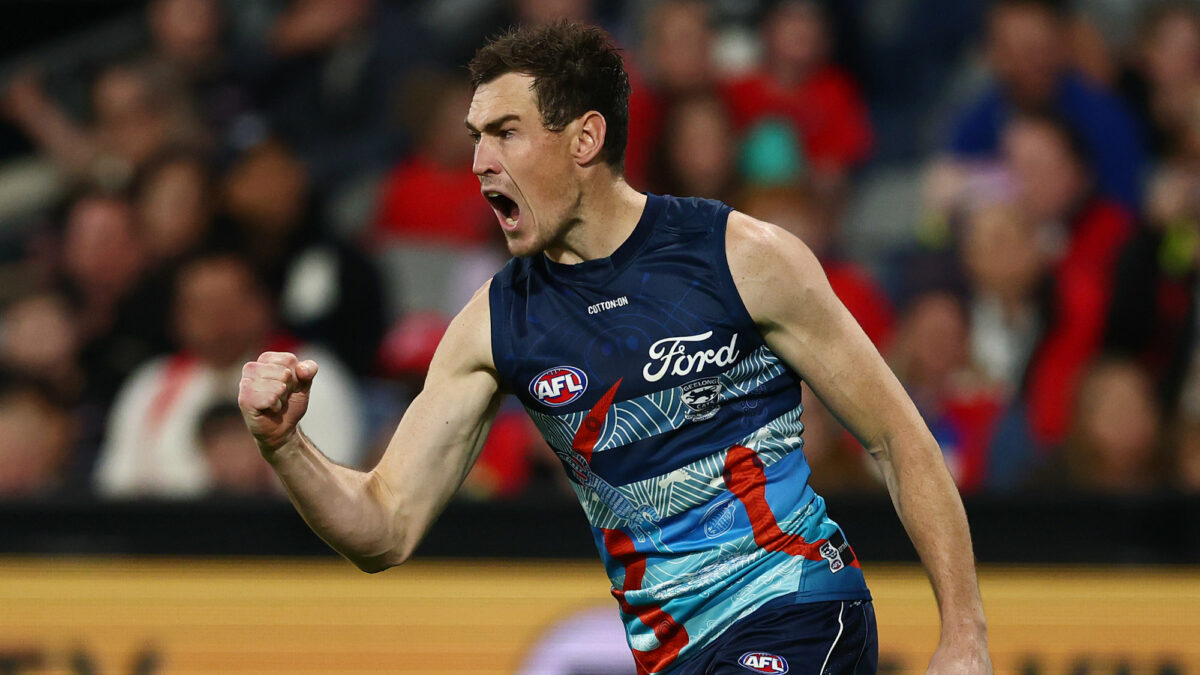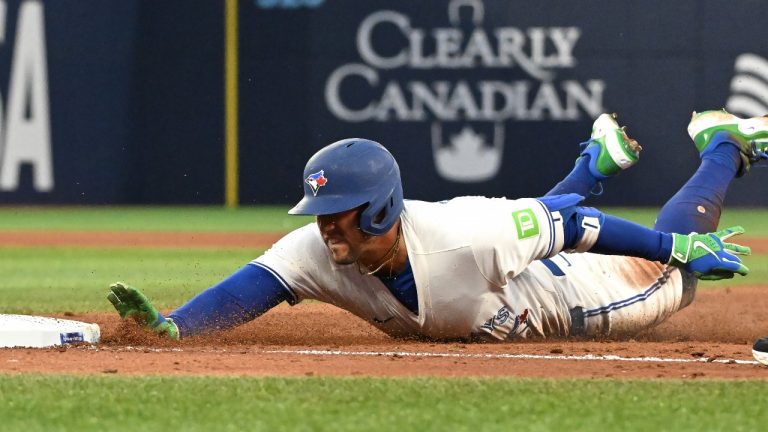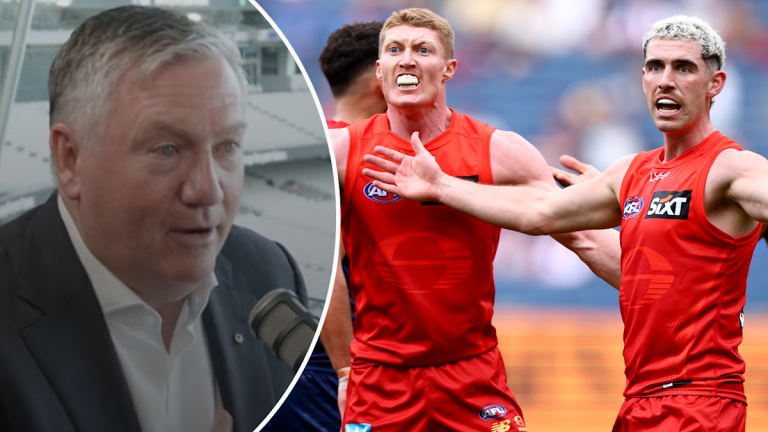Let’s get this out of the way first – yes, a 26-12 free kick differential is bad, but no, it wasn’t the reason Geelong beat the Western Bulldogs on Thursday night.
In the first half especially, the Dogs’ sloppiness by hand combined with the Cats’ ferocious, season-best pressure – their pressure factor of 209 for the second term far and away their highest for 2025 to date – to gift a string of holding the balls the home side’s way, while brilliant, intelligent kicking afforded them several more frees for infringing in marking contests.
No, the Bulldogs can’t and shouldn’t blame home cooking for their 14-point loss in what might just be the best, but was certainly the most exhilarating, match of the season – in truth, they only had themselves to blame.
The scoreboard gives the true indication: six extra scoring shots, yet 17 behinds to 7, sums up the difference between these two sides on the night … and, to be honest, in general.
The Dogs, after giving the Cats a lap’s break by shipping six consecutive goals in a withering second-quarter burst, were magnificent: ferocious at the contest, deadly from centre breaks and cutting the Cats’ defence to ribbons with entry after entry to dangerous positions.
The midfield was dominant, Rory Lobb a titan in defence to all but single-handedly hold Geelong at bay time and again, and whenever the ball came to ground inside forward 50, the pressure of Rhylee West, Laitham Vandermeer and co. forced loose ball after loose ball, and with it chances galore for the most ruthless team at scoring from clearances the stats have ever seen.
But against a Geelong outfit at their brilliant best – and you can be assured they were absolutely that – it isn’t enough to merely be ferocious, resilient, dangerous. For all intents and purposes, you have to be perfect.
The finishing let the Dogs down consistently; four kicks cannoned into the post, Khamis snapped from close range on the right side for a left-footer and hung it narrow in the third quarter, Aaron Naughton did likewise in the first term.
All up, 12 behinds to just eight goals were mustered from general play – some of the misses can, to be sure, be attributed to Geelong’s suffocating pressure, but far too often golden chances were spurned.
The lesson in contrast is that whenever a Cats player had a shot, more often than not it went through the big sticks. Whenever a Cats player had the chance to lace out a teammate inside 50, or kick to their advantage running back, more often than not it was nailed.
In the end, this became a match between a hulking, ten-foot-tall, muscle-bound giant holding an enormous spiked tomahawk … up against a speedy young man with a sniper rifle. However, close that giant ball of death came to splitting them open, no matter how emphatic their domination of stoppages, the Cats were only ever one headshot away from reasserting control.
The Dogs paid the price for realising too late the Cats’ ferocious pressure was too severe for the overlap handball game that ripped a bruise-free Essendon apart last week simply wasn’t going to work.
Time and time again a poor pass, or over-ambitious handball receive, would catch the Dogs on the hop trying to move the ball quickly – and once they did, the Cats seldom gave them an even break.
Facilitating it was the Dogs’ desire to run in waves, risking being opened up out the back in their attempt to deny Geelong numbers both around the ball and behind it; after this Jason Johannisen holding the ball, for instance, Bailey Smith had both Jeremy Cameron and Tyson Stengle inside 50 to choose from, with Rory Lobb given virtually no hope of stopping a walk-in goal.
This was the Cats’ path to victory, and it was executed virtually flawlessly.
Its strength was in how quickly the switch could be flipped: knowing the Dogs’ defensive vulnerabilities against fast ball, especially against a fleet-footed forward line like the Cats are blessed with, once the turnover was forced, it was all systems go.
After this Gryan Miers mark at half-back stymies a Dogs forward foray in the second term, for instance, it takes just 11 seconds – and two inch-perfect kicks – for the footy to end up in the goalsquare for Cameron to dribble through a crucial steadier amid a Bulldogs surge.
Yet the Dogs performed well whenever given the chance to lock the ball inside their 50, even if they had to bomb inside to get it. As illogical as it seems against the Cats, the masters of the air, the Dogs had great success at bringing the ball to ground – and as soon as it did, their underrated smalls, particularly West, got to work.
Once this miscalculation was addressed, allied to a stoppage domination, particularly from centre bounces, the tone of the match shifted – suddenly, it was the Dogs’ potency from clearances outweighing the Cats’ strength from turnover.
A flood of shots was the result: four of the last five of the third term around that crucial Cameron turnover goal, which kept the Dogs within touch ahead of the final term.
In the end, though, the difference between the two sides was summed up with a pair of key flashpoints at the game’s most crucial stage.
With the ball at half-forward for the Bulldogs, six and a half minutes on the clock, and scores tied, Max Holmes finds the ball in his possession, and with barely half a second to do something with it before he’s consumed, throws it on the boot.
As it floats in the area, it’s read perfectly by who else by Cameron, whose six goals have been match-defining in every sense of the word. A strong mark overhead, and as has been the case for the Cats all night, he’s off virtually as soon as he has two feet planted back on earth.
He doesn’t bother with hitting up a target – he hammers the ball as long as he can, turning the play into a footrace. Leading the pack lopes Shannon Neale, a man mountain of a teammate with a deceptive turn of pace.
Not for the first time, a Cats player has found himself out the back. Neale gathers, gives himself time to steady, and with James O’Donnell desperately converging, puts through the go-ahead goal.
From the very next centre bounce, the Bulldogs get the chance to weave their own magic. Bailey Smith wins it, but his hacked kick forward is interrupted by an oncoming Lobb, who forces the ball past two Cats, gathers and handballs towards Bontempelli.
Cue some Bont brilliance – with Jack Henry converging on him, he doesn’t take possession, instead tapping the ball on backwards and perfectly into the path of a sprinting Ed Richards. The overlap is set – no one’s catching Richards from behind, and with even numbers ahead someone will have to leave their man to try and stop him.
That man is Zach Guthrie, but it looks destined to be futile: as Richards hits 50, he chips a pass into the corridor, where Buku Khamis sits all on his own.

Did the kick have five centimetres’ too much on it? Did Khamis lose the footy in the lights? Was it a bit of both?
We may never know for sure, but all by himself, the ball floating seemingly in slow-motion towards him, Khamis topples backwards, the ball careening off his fingertips and to the ground.
The players converge, Mark O’Connor works a minor miracle to jar the footy free, win possession and kick clear.
The Cats took their chance at the game’s most crucial stage. The Dogs didn’t.
Sometimes, it really is as simple as that.







